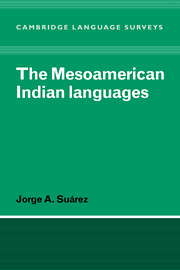Book contents
- Frontmatter
- Contents
- List of illustrations
- List of tables
- Preface
- Notational conventions
- Map 1 Present-day distribution of Mesoamerican Indian languages
- Table 1 Classification of Mesoamerican Indian languages and index to map 1
- 1 The study of Mesoamerican Indian languages
- 2 Dialects, languages and linguistic families
- 3 Phonology I
- 4 Phonology II
- 5 Morphology I
- 6 Morphology II
- 7 Syntax I
- 8 Syntax II
- 9 Preconquest literary traditions
- 10 The prehistory of Mesoamerican Indian languages
- 11 Indian languages after the conquest
- Appendix: Sources for sentences quoted in chapters 7 and 8
- References
- Language index
- Subject index
- Frontmatter
- Contents
- List of illustrations
- List of tables
- Preface
- Notational conventions
- Map 1 Present-day distribution of Mesoamerican Indian languages
- Table 1 Classification of Mesoamerican Indian languages and index to map 1
- 1 The study of Mesoamerican Indian languages
- 2 Dialects, languages and linguistic families
- 3 Phonology I
- 4 Phonology II
- 5 Morphology I
- 6 Morphology II
- 7 Syntax I
- 8 Syntax II
- 9 Preconquest literary traditions
- 10 The prehistory of Mesoamerican Indian languages
- 11 Indian languages after the conquest
- Appendix: Sources for sentences quoted in chapters 7 and 8
- References
- Language index
- Subject index
Summary
The distribution of topics in chapters 5–8 has been largely a matter of convenience of presentation since there is of course a good deal of overlap between syntax and morphology. In the present and the following chapters the discussion will refer to and supplement the morphological information given in chapters 5 and 6.
Differences in the order of constituents in a clause are currently used as a way of typologizing languages; as they are easily handled across whole language families, they will be treated early, in 7.1. Section 8.5 will be devoted to a brief discussion of the impact of Spanish on the syntactic structure of Mesoamerican Indian languages. The remainder of chapters 7 and 8 will be devoted to a consideration of various syntactic patterns, organized by language family. Those that will be considered are as follows:
Types of clauses according to number of participants, emphasis and voice.
Ways of expressing existential, identificational, locative, and possessive meanings at clause level.
Forms of interrogative clauses.
Marking of clause constituents according to function.
Forms of verbal phrases containing auxiliaries.
Major features of coordination.
Formation of relative clauses.
Ways of expressing comparison.
Some explanations about the terminology to be used are given in the following paragraphs.
Constructions containing a predicate will be referred to as ‘clauses’ without distinguishing them from ‘sentences’.
- Type
- Chapter
- Information
- The Mesoamerican Indian Languages , pp. 93 - 116Publisher: Cambridge University PressPrint publication year: 1983



